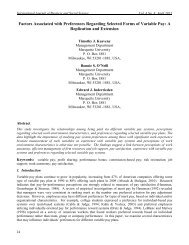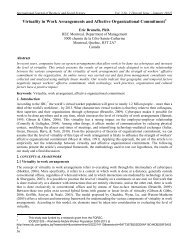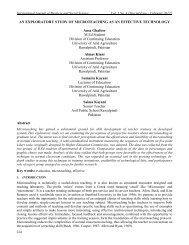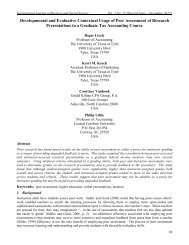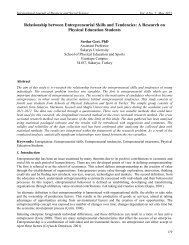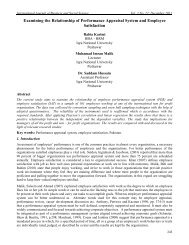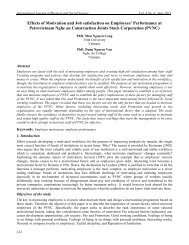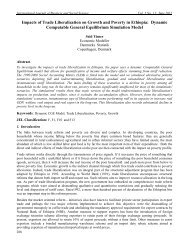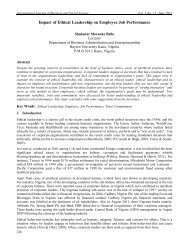Urban Myths Pertaining to Road Accidents in Zimbabwe: The Case ...
Urban Myths Pertaining to Road Accidents in Zimbabwe: The Case ...
Urban Myths Pertaining to Road Accidents in Zimbabwe: The Case ...
Create successful ePaper yourself
Turn your PDF publications into a flip-book with our unique Google optimized e-Paper software.
International Journal of Bus<strong>in</strong>ess and Social Science Vol. 3 No. 17; September 2012<br />
<strong>Urban</strong> <strong>Myths</strong> <strong>Perta<strong>in</strong><strong>in</strong>g</strong> <strong>to</strong> <strong>Road</strong> <strong>Accidents</strong> <strong>in</strong> <strong>Zimbabwe</strong>: <strong>The</strong> <strong>Case</strong> of Ch<strong>in</strong>hamo Service<br />
Centre along Seke <strong>Road</strong> (L<strong>in</strong>k<strong>in</strong>g Harare and Chitungwiza)<br />
Edw<strong>in</strong> Mhandu<br />
Lecturer<br />
English and Media Studies Department<br />
Faculty of Arts<br />
University of <strong>Zimbabwe</strong><br />
<strong>Zimbabwe</strong><br />
Takawira Kazembe<br />
Seniour Lecturer<br />
Department of Science and Mathematics Education<br />
Faculty of Education<br />
University of <strong>Zimbabwe</strong><br />
<strong>Zimbabwe</strong><br />
Abstract<br />
<strong>The</strong> paper explores urban myths concern<strong>in</strong>g road accidents that occur between the 16 kilometre and 17 kilometre<br />
pegs along Seke road l<strong>in</strong>k<strong>in</strong>g Harare and Chitungwiza <strong>in</strong> <strong>Zimbabwe</strong>. We argue that there exist a range of views<br />
with regard <strong>to</strong> the exact causes and nature of the carnage that occurs on the one kilometre stretch, that is from<br />
Koala <strong>to</strong> Ch<strong>in</strong>hamo service centre. Some people argue from a rational standpo<strong>in</strong>t that contribut<strong>in</strong>g fac<strong>to</strong>rs <strong>to</strong> the<br />
high accident rate <strong>in</strong>clude the bend <strong>in</strong> the road, the state of disrepair of the vehicles, and the condition of the<br />
road. However, this does not expla<strong>in</strong> the mysterious events often believed <strong>to</strong> take place on the Koala <strong>to</strong> Ch<strong>in</strong>hamo<br />
stretch of the road. With<strong>in</strong> Shona traditional belief systems, a place where accidents usually occur is haunted by<br />
the spirit(s) of a person or people who were murdered. <strong>The</strong> murdered people then come <strong>to</strong> haunt the liv<strong>in</strong>g until<br />
the liv<strong>in</strong>g a<strong>to</strong>ne for the murder. This paper considers the range of <strong>in</strong>terpretations given <strong>to</strong> the accidents on this<br />
road, and argues that further accidents can only be prevented if all <strong>in</strong>terpretations are recognized as valid.<br />
Keywords: African worldview, urban myths, road traffic accidents, traffic regulations, Christian worldview,<br />
Shona people<br />
Introduction<br />
<strong>The</strong>re are various <strong>in</strong>terpretations of the causes and the nature of accidents that occur at Ch<strong>in</strong>hamo Service centre,<br />
specifically the one kilometre stretch from Koala <strong>to</strong> Ch<strong>in</strong>hamo along Seke road. <strong>The</strong>se <strong>in</strong>terpretations are made by<br />
a broad spectrum of people <strong>in</strong>clud<strong>in</strong>g ord<strong>in</strong>ary citizens, traditionalists, the clergy, scholars, media practitioners,<br />
the police and above all people who frequently drive along the highway. In this paper, we argue that the<br />
<strong>in</strong>terpretations that one might dismiss as mythical may not necessarily be regarded as such by <strong>in</strong>dividuals who<br />
have witnessed the carnage first hand and who th<strong>in</strong>k scientific explanations are <strong>in</strong>sufficient. We derive the<br />
def<strong>in</strong>ition of myth from Isidore Okpewho who views myths as the basic imag<strong>in</strong>ative resource from which larger<br />
cultural values derive. <strong>Myths</strong> are <strong>in</strong>dicative of a society that is constantly engaged <strong>in</strong> creative imag<strong>in</strong>ation and<br />
also engages <strong>in</strong> ”abstract philosophical speculation”. In his sem<strong>in</strong>al text, Myth <strong>in</strong> Africa, Isidore Okpewho def<strong>in</strong>es<br />
myths <strong>in</strong> Africa, “not as tale-type or genre, but as a quality-that quality of fancy which <strong>in</strong>forms the creative and<br />
configurative powers for the human m<strong>in</strong>d <strong>in</strong> vary<strong>in</strong>g degrees of <strong>in</strong>tensity”.(Okpewho, 1983, 219). We suggest that<br />
non-scientific responses <strong>to</strong> road accidents are such an <strong>in</strong>stance of “fancy” and should not simply be dismissed.<br />
From the first of May 2008 <strong>to</strong> the thirty first of May 2009, thirty-two (32) fatal accidents at the one kilometre<br />
stretch were recorded; there were a hundred <strong>in</strong>juries and fourteen fatalities <strong>in</strong> n<strong>in</strong>e of these accidents.(Traffic<br />
Accident Book (TAB) Register, ZRP Hatfield. 2008-9). Prior <strong>to</strong> this period, a bus from Harare <strong>to</strong> Chitungwiza<br />
overturned <strong>in</strong> unexpla<strong>in</strong>able circumstances and many people were <strong>in</strong>jured on the same stretch of road,<br />
94
© Centre for Promot<strong>in</strong>g Ideas, USA www.ijbssnet.com<br />
<strong>The</strong> confusion was worsened when a good Samaritan who was assist<strong>in</strong>g <strong>in</strong> carry<strong>in</strong>g the <strong>in</strong>jured <strong>in</strong><strong>to</strong> ambulances<br />
had his car rammed <strong>in</strong><strong>to</strong>. People started speculation concern<strong>in</strong>g the possible supernatural causes of the accident.<br />
<strong>Road</strong> accidents at Ch<strong>in</strong>hamo Service centre along Seke road are a cause for concern for any who would care <strong>to</strong><br />
give consideration <strong>to</strong> the frequency and the <strong>to</strong>ll of accidents, bear<strong>in</strong>g <strong>in</strong> m<strong>in</strong>d that the Harare <strong>to</strong> Chitungwiza<br />
highway is among the f<strong>in</strong>est of <strong>Zimbabwe</strong>’s roads, boast<strong>in</strong>g of a dual carriageway that it is <strong>in</strong> a relatively good<br />
condition. Chitungwiza residents who use the highway on a daily basis often witness fatal accidents and at times<br />
the wreckage takes time <strong>to</strong> clear, creat<strong>in</strong>g massive traffic jams that often lead <strong>to</strong> more accidents. Chitungwiza is a<br />
satellite <strong>to</strong>wn located 30 kilometres <strong>to</strong> the South of Harare and has an approximate population of 600 000<br />
accord<strong>in</strong>g <strong>to</strong> the census of 2012 (Pilot census, Central statistical office, 2012). To alleviate the transport problems<br />
with<strong>in</strong> the satellite <strong>to</strong>wn the government has s<strong>in</strong>ce mooted the idea of hav<strong>in</strong>g a railway l<strong>in</strong>k between Harare and<br />
Chitungwiza, but this has not yet materialised. <strong>The</strong> Chitungwiza residents do not know about the developments<br />
and the challenges the government is fac<strong>in</strong>g concern<strong>in</strong>g the railway.<br />
<strong>The</strong>re are a few <strong>in</strong>dustries <strong>to</strong> the western flank of the <strong>to</strong>wn which barely employ fifteen thousand people and the<br />
major bus<strong>in</strong>ess is retail, which is often carried out by <strong>in</strong>formal traders. A greater percentage of the work<strong>in</strong>g class<br />
people work <strong>in</strong> Harare and some go <strong>to</strong> do their personal bus<strong>in</strong>ess <strong>in</strong> Harare.<br />
Methodology<br />
Collection of data for this study was done through questionnaires and <strong>in</strong>terviews on randomly selected<br />
respondents. Among these respondents were commuter omnibus drivers (45), police officers (90), passengers<br />
(150), private vehicle drivers (55), traditionalists (100), religious congregations (Roman Catholics (50), Anglicans<br />
(50), Methodists (45), Apos<strong>to</strong>lic Faith members (71), Pentecostals (55), religious leaders/elders (50),<br />
pas<strong>to</strong>rs/m<strong>in</strong>isters/priests (45). Actual data on the number of accidents that occurred between May 2008 and May<br />
2009, the number of deaths and the number of <strong>in</strong>juries were collected from Hatfield police station with the<br />
approval of Police General headquarters. <strong>The</strong> sample varied from group <strong>to</strong> group on a slid<strong>in</strong>g scale. Out of the<br />
three Police stations <strong>in</strong> Chitungwiza, questionnaires were responded <strong>to</strong> by about 30% of officers on each station.<br />
Drivers and passengers of commuter omnibuses were <strong>in</strong>terviewed at convenient bus s<strong>to</strong>ps along the road, Private<br />
mo<strong>to</strong>rists were <strong>in</strong>terviewed at the service station on this bad stretch. Religious people were <strong>in</strong>terviewed at their<br />
usual places of congregation,<br />
Analysis of Data and Research f<strong>in</strong>d<strong>in</strong>gs<br />
Responses from the questionnaires and verbal <strong>in</strong>terviews, about what the causes of the accidents were, can be<br />
categorized under the follow<strong>in</strong>g head<strong>in</strong>gs: Shona religious and cultural beliefs, Christian beliefs, and references <strong>to</strong><br />
the road traffic regulations and laws. In the Ch<strong>in</strong>hamo debacle, various views and op<strong>in</strong>ions were put across by<br />
many people and some of them can easily be dismissed as make belief s<strong>to</strong>ries. However <strong>to</strong> those who have<br />
witnessed some of the carnage and <strong>to</strong> people who believe <strong>in</strong> Christianity and those who believe <strong>in</strong> Shona<br />
cosmology, there is noth<strong>in</strong>g unreal about the s<strong>to</strong>ries, these are real s<strong>to</strong>ries and their causes, these people feel<br />
strongly, need <strong>to</strong> be addressed as a matter of urgency as failure only may lead <strong>to</strong> further deaths. Asked about the<br />
ma<strong>in</strong> cause of accidents at the place, one respondent, Tawanda Zv<strong>in</strong>airo* po<strong>in</strong>ted out: ”People say, two people<br />
were run over by a car there way back” (the respondent could not remember when exactly) “and from that<br />
moment, accidents began <strong>to</strong> occur but l don’t know how far true it is”.<br />
Another respondent, Maidei Jamu* had this <strong>to</strong> say:”That is a tricky place because people testify see<strong>in</strong>g people or<br />
figures on the way and if they try <strong>to</strong> avoid them they get off the road and an accident occurs”. Another version of<br />
the later response goes, a beautiful woman wear<strong>in</strong>g a wig is often seen at night, smil<strong>in</strong>g and beckon<strong>in</strong>g <strong>to</strong><br />
<strong>in</strong>dividual mo<strong>to</strong>rists and those who know that she is a visitation simply run over her. What they only hear is “wigi<br />
yangu, wigi yangu!” (My wig, my wig!) as the woman disappears <strong>in</strong><strong>to</strong> th<strong>in</strong> air. When such s<strong>to</strong>ries are exchanged<br />
by commuters pass<strong>in</strong>g by the place, some women do not take this lightly, at times they <strong>in</strong>terject and po<strong>in</strong>t out that<br />
actually babies are seen crawl<strong>in</strong>g and as drivers try <strong>to</strong> avoid them, they get <strong>in</strong>volved <strong>in</strong> fatal accidents. To further<br />
confirm this, the arguments go, that is why the place claims a lot of children. One driver testified that he of all the<br />
people did not believe that there was anyth<strong>in</strong>g amiss at the place up <strong>to</strong> a po<strong>in</strong>t when <strong>in</strong> one of the even<strong>in</strong>g drives<br />
he felt his hand clasped and the steer<strong>in</strong>g wheel got twisted as the vehicle made for the ditch, he only survived, as<br />
he puts it , by shout<strong>in</strong>g the name “Jesus” and stamp<strong>in</strong>g on the clutch and brake pedals.<br />
95
International Journal of Bus<strong>in</strong>ess and Social Science Vol. 3 No. 17; September 2012<br />
He argued that, usually, the visitations target lone drivers and even where there are many people <strong>in</strong> the vehicle the<br />
visitations may only present themselves <strong>to</strong> the driver.<br />
One s<strong>to</strong>ry goes: A kombi was travell<strong>in</strong>g from Harare <strong>to</strong> Chitungwiza and there was a man who was wear<strong>in</strong>g a hat<br />
that almost rendered his face <strong>in</strong>visible, seated next <strong>to</strong> the driver among other passengers. When the Kombi got <strong>to</strong><br />
Koala, a woman seated at the back seat got <strong>in</strong><strong>to</strong> a trance and all of a sudden ordered the driver <strong>to</strong> s<strong>to</strong>p the vehicle<br />
immediately as there was an accident about <strong>to</strong> happen that would kill some passengers. Other passengers asked<br />
the driver <strong>to</strong> comply and truly the Kombi came <strong>to</strong> a screech<strong>in</strong>g halt. It later turned out that the woman belonged <strong>to</strong><br />
the apos<strong>to</strong>lic sect. She claimed that she had been <strong>in</strong>structed by the Holy Spirit She asked every man <strong>to</strong> take off<br />
his hat before they passed along the Ch<strong>in</strong>hamo area and men who had hats <strong>in</strong> the Kombi complied except for the<br />
one seated next with the driver. It was observed, he was not keen and this <strong>in</strong>vited vitriol from other passengers as<br />
they claimed they were beh<strong>in</strong>d time.<br />
One dar<strong>in</strong>g passenger snatched the hat off only for everybody <strong>to</strong> realize that there was no head. At this juncture<br />
the man disappeared <strong>in</strong><strong>to</strong> th<strong>in</strong> air, for it was an apparition. <strong>The</strong> woman, still <strong>in</strong> a trance, <strong>to</strong>ok charge, s<strong>in</strong>g<strong>in</strong>g<br />
“Hosanna” and everybody else <strong>in</strong> the Kombi began s<strong>in</strong>g<strong>in</strong>g, chant<strong>in</strong>g prayers as the Kombi moved slowly past the<br />
stretch of the road adjacent <strong>to</strong> Ch<strong>in</strong>hamo service centre. Takawira Kazembe (2012) shows that lead<strong>in</strong>g spirit<br />
mediums <strong>in</strong> <strong>Zimbabwe</strong> who were consulted about similar phenomena say that when a person dies he goes <strong>to</strong> a<br />
state of existence where he/she jo<strong>in</strong>s his/her ances<strong>to</strong>rs. <strong>The</strong>y exam<strong>in</strong>e his/her life activities before they accept<br />
him/her <strong>in</strong><strong>to</strong> their ranks. If there are outstand<strong>in</strong>g issues the ances<strong>to</strong>rs order him/her <strong>to</strong> go back and get the issues<br />
rectified. For example, if the deceased was murdered, they will order him/her <strong>to</strong> go back and ensure that<br />
restitution is effected. <strong>The</strong> soul of the deceased will attempt <strong>to</strong> obta<strong>in</strong> restitution. It plays havoc on the<br />
murderer(s). If, for some reason, the murderer does not pay up, the deceased tries all tricks <strong>to</strong> ga<strong>in</strong> the attention of<br />
those ignor<strong>in</strong>g it. <strong>The</strong>se tricks may <strong>in</strong>clude harass<strong>in</strong>g people who pass by the scene of murder.<br />
<strong>The</strong> question people ask is whether these visitations are real or whether they are merely diversionary statements<br />
by reckless and drunk drivers who would be keen <strong>to</strong> shirk crim<strong>in</strong>al liability. <strong>The</strong>re are s<strong>to</strong>ries of drivers who see<br />
forests <strong>in</strong> front of them on the road, and apply emergence brakes <strong>to</strong> avoid hitt<strong>in</strong>g trees, only <strong>to</strong> realize there were<br />
no trees. <strong>The</strong>re are other s<strong>to</strong>ries of drivers try<strong>in</strong>g <strong>to</strong> avoid herds of cattle on the road. <strong>The</strong> drivers <strong>in</strong> turn employ<br />
all possible avoidance manoeuvres aga<strong>in</strong>st nonexistent cattle only <strong>to</strong> get <strong>in</strong>volved <strong>in</strong> accidents. <strong>The</strong>re is a s<strong>to</strong>ry of<br />
a man who was develop<strong>in</strong>g a property <strong>in</strong> Borrowdale, <strong>in</strong> the Eastern suburbs of Harare but lived <strong>in</strong> the western<br />
suburbs of Harare. He visited his Borrowdale property on a Friday afternoon and was there until sunset. On his<br />
way <strong>to</strong> the western suburbs he s<strong>to</strong>pped at the shopp<strong>in</strong>g center close <strong>to</strong> Borrowdale Police Station and met two<br />
friends. <strong>The</strong> man does not dr<strong>in</strong>k alcohol but he sat with his dr<strong>in</strong>k<strong>in</strong>g friends at a restaurant. At about 8 pm he <strong>to</strong>ld<br />
his friends that he was go<strong>in</strong>g home. <strong>The</strong> friends asked for a lift <strong>to</strong> their home <strong>in</strong> the area. After leav<strong>in</strong>g his friends,<br />
the man decided <strong>to</strong> drive <strong>to</strong>wards a road he knew well, and while driv<strong>in</strong>g <strong>to</strong>wards that road, the man saw a forest<br />
ahead of him.<br />
Suddenly, there was no road and he felt he was hitt<strong>in</strong>g trees. He f<strong>in</strong>ally s<strong>to</strong>pped the car, got out <strong>to</strong> <strong>in</strong>spect for<br />
damages on the car. F<strong>in</strong>d<strong>in</strong>g no damage on the car, he opened the driver’s door <strong>to</strong> proceed on his journey home.<br />
He suddenly heard a woman’s voice: “Are you alright?” <strong>The</strong> man answered: “Yes I am OK. But I am not sure<br />
about the car.” Confident that there was a person <strong>to</strong> share the experience, he went round the car aga<strong>in</strong>, light<strong>in</strong>g a<br />
cigarette <strong>in</strong> the process. <strong>The</strong> woman said “You are lucky because many people have died here!”He suddenly<br />
realized that the very tall white lady had vanished. He proceeded home at between 5 and 10 km per hour, very<br />
scared. His flight <strong>to</strong> Kenya was at 11.00 am the follow<strong>in</strong>g morn<strong>in</strong>g. He visited the scene of his ordeal. <strong>The</strong>re were<br />
no trees. All he saw were the skid marks. On his return from Nairobi 3 weeks later his friends <strong>to</strong>ld him that he<br />
should have followed their advice and followed the directions they had given him. <strong>The</strong>y said a prom<strong>in</strong>ent man had<br />
killed his wife at that spot. A few months later, a prom<strong>in</strong>ent bus<strong>in</strong>essman had a fatal accident on the same spot.<br />
Writ<strong>in</strong>g on the causes of a str<strong>in</strong>g of terrible crashes on Harare <strong>to</strong> Masv<strong>in</strong>go highway <strong>in</strong> <strong>Zimbabwe</strong> <strong>in</strong> an article<br />
entitled, “<strong>Zimbabwe</strong>ans say angry ances<strong>to</strong>rs beh<strong>in</strong>d road accidents” posted on the website on 11 December 2009;<br />
Robyn Dixon reports that some people po<strong>in</strong>t out that traditional rituals <strong>to</strong> appease the dead have not been<br />
performed for years. Among some visitations reported by ord<strong>in</strong>ary people, it is said that there are “pedestrians<br />
cross<strong>in</strong>g the road at night, dressed <strong>in</strong> black, walk<strong>in</strong>g so slowly that drivers are forced <strong>to</strong> swerve -- ghostly figures<br />
not made of sk<strong>in</strong> and bone are reported as walk<strong>in</strong>g at the place.<br />
96
© Centre for Promot<strong>in</strong>g Ideas, USA www.ijbssnet.com<br />
In addition, it is said that the mermaid <strong>in</strong> the Pimbi river, got angry at the blood and gasol<strong>in</strong>e spilled when a bus<br />
crashed <strong>in</strong><strong>to</strong> the water two years ago and went on <strong>to</strong> cause more accidents.(Ibid). As is clear from this report from<br />
Dixon, there are cultural <strong>in</strong>terpretations for the phenomenon. In <strong>Zimbabwe</strong>, lead<strong>in</strong>g spirit mediums po<strong>in</strong>t out that<br />
places like the one kilometre peg between Koala and Ch<strong>in</strong>hamo need <strong>to</strong> be cleansed ritually by spiritual<br />
practitioners who will plead with the spirit <strong>to</strong> leave the <strong>in</strong>nocent people alone and obta<strong>in</strong> restitution from the<br />
murderer. <strong>The</strong>se spiritual practitioners will plead with the ances<strong>to</strong>rs of the spirit <strong>to</strong> assist the suffer<strong>in</strong>g soul. <strong>The</strong>y<br />
assist the spirit <strong>to</strong> locate the perpetra<strong>to</strong>r(s) and achieve restitution. Accord<strong>in</strong>g <strong>to</strong> lead<strong>in</strong>g spirit mediums, there is<br />
no other way <strong>to</strong> solve the problem of aveng<strong>in</strong>g spirits except restitution, and many <strong>Zimbabwe</strong>ans hold this view<br />
<strong>to</strong>o. A further dimension <strong>to</strong> this is that it is believed by many that the deceased will entice the perpetra<strong>to</strong>r(s) <strong>to</strong><br />
commit more murders, as if <strong>to</strong> say, you killed me, kill others so that I shall have company. When the soul of the<br />
deceased is sent back <strong>to</strong> achieve restitution, it is believed, it goes back <strong>to</strong> the scene of death and tries <strong>to</strong> locate the<br />
perpetra<strong>to</strong>r.<br />
It tries <strong>to</strong> attract attention and causes unexpla<strong>in</strong>able events <strong>to</strong> occur, <strong>in</strong>clud<strong>in</strong>g some which lead <strong>to</strong> further<br />
accidents. Further accidents lead <strong>to</strong> <strong>in</strong>creased numbers of spirits need<strong>in</strong>g appeasement and the location becomes a<br />
black spot. Unexpla<strong>in</strong>able events will be occurr<strong>in</strong>g at the scene of the murders,unreal people will be noticed do<strong>in</strong>g<br />
all sorts of th<strong>in</strong>gs: loiter<strong>in</strong>g, draw<strong>in</strong>g peoples’ attention, handl<strong>in</strong>g mov<strong>in</strong>g cars’ steer<strong>in</strong>g wheels, sitt<strong>in</strong>g on bonnets<br />
of mov<strong>in</strong>g cars, runn<strong>in</strong>g along mov<strong>in</strong>g cars, etc.<strong>The</strong> perpetra<strong>to</strong>r(s) of the kill<strong>in</strong>gs, many believe, have <strong>to</strong> pay<br />
restitution and only then will the problem cease. Accord<strong>in</strong>g <strong>to</strong> lead<strong>in</strong>g spirit mediums, when the murdered get<br />
compensated, the situation normalizes. Comment<strong>in</strong>t<strong>in</strong>g on the arguments put forward by lead<strong>in</strong>g spirit mediums,<br />
Michael Bourdillon (1998) argues that among the Shona aveng<strong>in</strong>g spirits are terrify<strong>in</strong>g and can attack harshly and<br />
suddenly. <strong>The</strong>re is also a less positive side <strong>to</strong> this as “an angry spirit is not easily appeased. Thus the angry spirit<br />
of a man murdered some eighty years ago is believed <strong>to</strong> have caused the death of the two brothers who plotted the<br />
murder, their father and six of their children, and still <strong>to</strong> claim the occasional victim among their descendants<br />
while the surviv<strong>in</strong>g relatives are still try<strong>in</strong>g <strong>to</strong> raise the large f<strong>in</strong>e <strong>in</strong> cattle necessary <strong>to</strong> appease the<br />
spirit.”(Bourdillon, 1998: 233)<br />
In the above, Bourdillon reports the belief that the spirit of the dead demands retribution from the liv<strong>in</strong>g relatives<br />
and children of someone who has committed murder. This is only redressed, it is believed, when the perpetra<strong>to</strong>r’s<br />
family a<strong>to</strong>nes through payment of cattle and a virg<strong>in</strong> girl as the deceased victim’s family’s demands. This is<br />
corroborated by Takawira Kazembe (2012) who reports that members of the perpetra<strong>to</strong>r’s family, both the nuclear<br />
and extended family, are believed <strong>to</strong> fall victim <strong>to</strong> purges by the spirit of the deceased victim and do not have<br />
viable options other than pay<strong>in</strong>g the victim’s family. Whereas it is true <strong>to</strong> say that Human rights pressure groups<br />
and the Girl Child Network <strong>in</strong> <strong>Zimbabwe</strong> have been on the forefront fight<strong>in</strong>g aga<strong>in</strong>st the practice of a<strong>to</strong>n<strong>in</strong>g with<br />
an <strong>in</strong>nocent virg<strong>in</strong> girl alongside a herd of cattle, <strong>in</strong> many <strong>in</strong>stances the practice still happens and goes on<br />
unreported. This shows the significance attached <strong>to</strong> the fact that the carnage is unders<strong>to</strong>od <strong>to</strong> be caused by the<br />
ngozi (the deceased aveng<strong>in</strong>g spirit) Thus at the Koala <strong>to</strong> Ch<strong>in</strong>hamo stretch, it is not uncommon <strong>to</strong> hear drivers<br />
who believe <strong>in</strong> these visitations talk<strong>in</strong>g <strong>to</strong> themselves whenever they have near misses <strong>to</strong> accidents <strong>to</strong> the effect<br />
that:”Siyana neni, hand<strong>in</strong>a ukama newe uye hand<strong>in</strong>a mhosva newe”. (Leave me alone, l am not related <strong>to</strong> you and<br />
I do not have any crime aga<strong>in</strong>st you).<br />
Respondents <strong>to</strong> the questionnaire, both men and women selected randomly by the researchers, also relayed their<br />
fears of foul play by bus<strong>in</strong>ess people who operate commuter omnibuses, buses and kombis. Generally,<br />
respondents expressed their belief that bus<strong>in</strong>ess people are <strong>in</strong> the habit of sacrific<strong>in</strong>g <strong>in</strong>nocent people <strong>to</strong> enable<br />
their bus<strong>in</strong>esses <strong>to</strong> flourish. <strong>The</strong> practice, known as kuchekeresa <strong>in</strong> Shona is often exaggerated <strong>to</strong> such an extent<br />
that it is held <strong>to</strong> be the norm, <strong>in</strong> accusations aga<strong>in</strong>st greedy bus<strong>in</strong>ess people who are suspected of us<strong>in</strong>g body parts<br />
of victims <strong>to</strong> create strong charms that <strong>in</strong> turn make those bus<strong>in</strong>esses flourish. In one of the accidents that<br />
occurred at Ch<strong>in</strong>hamo, it is rumoured that one child corpse was found beheaded and the head was never<br />
recovered. Tendai Madhuveko* whose cous<strong>in</strong> got killed <strong>in</strong> one fatal accident <strong>in</strong> a m<strong>in</strong>ibus that claimed n<strong>in</strong>e lives<br />
<strong>in</strong> Nyanyadzi* claimed that there were two children and a cous<strong>in</strong> of the owner of the m<strong>in</strong>ibus among the n<strong>in</strong>e<br />
deceased. <strong>The</strong> omnibus owner, who is also a bishop of a certa<strong>in</strong> ‘mysterious church’ <strong>in</strong>sisted that the funeral of<br />
his deceased children was <strong>to</strong> be held at a private location <strong>in</strong> Harare and only church members were allowed <strong>to</strong><br />
attend the funeral and not relatives. <strong>The</strong> bus<strong>in</strong>ess owner is known <strong>to</strong> have bought a herd of twenty cattle and four<br />
new omnibuses some few weeks after the funeral. To Madhuveko, this can only be <strong>in</strong>dicative of the levels of<br />
greed and unscrupulousness that prevail <strong>in</strong> the society.<br />
97
International Journal of Bus<strong>in</strong>ess and Social Science Vol. 3 No. 17; September 2012<br />
Of course the Police dismissed such claims as mythical and not corroborated by evidence. However, we argue<br />
that some of the s<strong>to</strong>ries and their <strong>in</strong>terpretations are only <strong>to</strong>o real <strong>in</strong> the m<strong>in</strong>ds of ord<strong>in</strong>ary <strong>Zimbabwe</strong>ans, and that<br />
any response <strong>to</strong> these accidents cannot simply dismiss ord<strong>in</strong>ary people’s understand<strong>in</strong>gs of events. <strong>The</strong> societal<br />
beliefs <strong>in</strong> the existence of such practices mean that ord<strong>in</strong>ary people, at least subconsciously, draw connections<br />
between events and the lives of those whose bus, omnibus or kombi has been <strong>in</strong>volved <strong>in</strong> an accident. When they<br />
discover that a certa<strong>in</strong> bus<strong>in</strong>ess person’s buses or kombis are time and aga<strong>in</strong> <strong>in</strong>volved <strong>in</strong> accidents, they may<br />
demand <strong>to</strong> have them outlawed and permits resc<strong>in</strong>ded irrespective of the fact that the vehicles may be <strong>in</strong> good<br />
condition. <strong>The</strong> hidden text <strong>in</strong> the outcry is that the bus<strong>in</strong>ess person has bad charms that cost the public a heavy <strong>to</strong>ll<br />
<strong>in</strong> terms of life. This practice is captured <strong>in</strong> some literary texts by <strong>Zimbabwe</strong>ans notably Claudius Matsikiti’s<br />
Akadzipwa neganda remhuru (He, the expert, was choked by the sk<strong>in</strong> of a calf), Bisset Chitsike’s Wakandigona<br />
wena (You Managed Me) and George Mujajati’s <strong>The</strong> sun will rise aga<strong>in</strong>. In the later text, Mujajati gives reader’s<br />
<strong>in</strong>sight <strong>in</strong><strong>to</strong> the m<strong>in</strong>d of a certa<strong>in</strong> wayward bus<strong>in</strong>essman.<br />
Nyati, the bus<strong>in</strong>essman who murders a child called Thabitha contemplates:<br />
98<br />
My n’anga has promised that he can prepare me a lot more powerful charms if I could br<strong>in</strong>g him<br />
the private parts and the heart of a young <strong>in</strong>nocent virg<strong>in</strong>. That <strong>in</strong>nocence would be the fac<strong>to</strong>r that<br />
would effectively bl<strong>in</strong>d anyone <strong>to</strong> any crime I would have committed… (Also)…the charm would<br />
br<strong>in</strong>g me unbelievably immense wealth and political power. (Mujajati, 1999, p92)<br />
<strong>The</strong> kuchekeresa practice is believed by ord<strong>in</strong>ary people <strong>to</strong> be rampant, yet these ord<strong>in</strong>ary people barely provide<br />
substantive evidence of such cases. When they discuss matters <strong>to</strong> do with accidents where many people die, they<br />
often do not dare mention names of people they believe <strong>to</strong> be the perpetra<strong>to</strong>rs of the evil spell, as they risk be<strong>in</strong>g<br />
taken <strong>to</strong> court for contraven<strong>in</strong>g <strong>The</strong> Witchcraft Suppression Act [Chapter 9:19] of the <strong>Zimbabwe</strong>an Constitution<br />
which makes it a crime <strong>to</strong> accuse anyone of witchcraft. <strong>The</strong>re are times when it becomes a muffled public secret<br />
that x and y’s buses must not be boarded as they become renowned for claim<strong>in</strong>g people’s lives through accidents.<br />
Thus, <strong>in</strong> <strong>Zimbabwe</strong>, buses servic<strong>in</strong>g long routes have been subject <strong>to</strong> public scrut<strong>in</strong>y. One bus<strong>in</strong>essman had <strong>to</strong><br />
change the pa<strong>in</strong>t colours of his buses because he was runn<strong>in</strong>g out of bus<strong>in</strong>ess as the company became known for<br />
be<strong>in</strong>g <strong>in</strong>volved <strong>in</strong> accidents which the government was on record declar<strong>in</strong>g national disasters. <strong>The</strong> classification<br />
of accidents as “national disasters” often occur when many people die <strong>in</strong> a s<strong>in</strong>gle accident <strong>in</strong> <strong>Zimbabwe</strong> and the<br />
government assists the bereaved families with food, coff<strong>in</strong>s <strong>to</strong> bury their deceased ( those who would have died<br />
out of the accident.<br />
Causes of <strong>Accidents</strong> accord<strong>in</strong>g <strong>to</strong> the Christian World View<br />
• In May 2009, various church denom<strong>in</strong>ations gathered <strong>to</strong> hold prayers and church services at the open ground<br />
that is near the place of the accidents. Comment<strong>in</strong>g on the demography of religious group<strong>in</strong>gs <strong>in</strong> <strong>Zimbabwe</strong>,<br />
Munetsi Ruzivo (2012) puts Christianity (<strong>in</strong>clud<strong>in</strong>g syncretic forms) at 85% of the whole population about<br />
10,200,000(Apos<strong>to</strong>lic 33%, Pentecostal 17%, Protestant 16%, Roman Catholic 10%, Other Christian 8%). <strong>The</strong><br />
dom<strong>in</strong>ant churches are the African Church, the, Anglican Church, the Baptist Church, the Lutheran Church,<br />
the Reformed Church and the Roman Catholic Church. <strong>The</strong> <strong>in</strong>terdenom<strong>in</strong>ational gather<strong>in</strong>g <strong>in</strong>cluded people<br />
from a cross section of the aforementioned churches. A well wisher also provided a trac<strong>to</strong>r and mowers <strong>to</strong> clear<br />
the place of long grass and <strong>to</strong> <strong>in</strong>crease visibility. An <strong>in</strong>terview with one of the pas<strong>to</strong>rs, Reverend Kachipapa<br />
K<strong>in</strong>g of the Evangelical Fellowship of <strong>Zimbabwe</strong> who organised the <strong>in</strong>terdenom<strong>in</strong>ational service revealed that<br />
Christians view the place as a battleground where the devil had been waylay<strong>in</strong>g humanity. In Christian<br />
cosmology, the devil is believed <strong>to</strong> be a rebel angel, Lucifer who was thrown from heaven after disobey<strong>in</strong>g<br />
God. It is also believed that the devil is go<strong>in</strong>g <strong>to</strong> face judgment for the disobedience. As the devil awaits<br />
judgment day, it is believed that this renegade angel is busy caus<strong>in</strong>g havoc <strong>to</strong> humank<strong>in</strong>d and also recruit<strong>in</strong>g<br />
mank<strong>in</strong>d <strong>to</strong> go with him/her <strong>to</strong> hell (a place believed <strong>to</strong> harbour an everlast<strong>in</strong>g <strong>in</strong>ferno). Comment<strong>in</strong>g on the<br />
Ch<strong>in</strong>hamo debacle, Reverend Kachipapa K<strong>in</strong>g po<strong>in</strong>ted out that the place harbours terri<strong>to</strong>rial spirits which need<br />
<strong>to</strong> be bound lest the devil’s k<strong>in</strong>gdom would flourish (Kachipapa K<strong>in</strong>g, 2010). <strong>The</strong> pas<strong>to</strong>r went on <strong>to</strong> quote<br />
Ephesians chapter 6 verse 12 which states “For we do not wrestle aga<strong>in</strong>st flesh and blood, but aga<strong>in</strong>st<br />
pr<strong>in</strong>cipalities, aga<strong>in</strong>st powers, aga<strong>in</strong>st the rulers of the darkness of this age, aga<strong>in</strong>st spiritual hosts of<br />
wickedness <strong>in</strong> the heavenly places. <strong>The</strong>refore take the whole armour of God, that you may be able <strong>to</strong> withstand<br />
<strong>in</strong> the evil day , and hav<strong>in</strong>g done all, <strong>to</strong> stand.”(Revised Standard Version of the Bible, Ephesians 6, vs 12)
© Centre for Promot<strong>in</strong>g Ideas, USA www.ijbssnet.com<br />
Thus, the idea of hav<strong>in</strong>g a church service at the place was done <strong>in</strong> the belief that it was a way of fight<strong>in</strong>g the evil<br />
spirits and chas<strong>in</strong>g the demon that was frequent<strong>in</strong>g the place. He further po<strong>in</strong>ted out that there was a whole<br />
subject of demonology and the type of demon that afflicted such places could be a district or prov<strong>in</strong>cial spirit and<br />
these demons are different from the cont<strong>in</strong>ental spirits that afflicted whole cont<strong>in</strong>ents. Echo<strong>in</strong>g the same<br />
sentiments, Shamiso Nyamupachitu* who attended the service po<strong>in</strong>ted out that when th<strong>in</strong>gs proved <strong>to</strong> be difficult<br />
<strong>to</strong> understand, Jesus was the answer hence she subscribed <strong>to</strong> the idea of hold<strong>in</strong>g prayer meet<strong>in</strong>gs at the place. She<br />
<strong>in</strong>sisted that the spirit of death itself needs <strong>to</strong> be cast away. Another respondent who attended the service, Edward<br />
Nyamapfeka* po<strong>in</strong>ted out that what was happen<strong>in</strong>g at the place could only be <strong>in</strong>terpreted as the devil’s<br />
mach<strong>in</strong>ations and these mach<strong>in</strong>ations can easily be detected because prior <strong>to</strong> such serious accidents, it is not<br />
unusual <strong>to</strong> see dogs and cats run over by cars especially on the highway <strong>in</strong> the Hatfield area. Christians were<br />
quick <strong>to</strong> dismiss the idea that spirit mediums would provide a solution by help<strong>in</strong>g assuage the aggrieved spirits.<br />
<strong>The</strong>re was general consensus among Christian respondents that the devil is the ma<strong>in</strong> culprit and no amount of<br />
recompense can satiate the devil’s desire for blood and evil actions.<br />
A commenta<strong>to</strong>r on Christianity and spirit beliefs <strong>in</strong> Africa Coll<strong>in</strong>s Armah writes that “the constant attribution of<br />
everyth<strong>in</strong>g (<strong>in</strong>clud<strong>in</strong>g road accidents) <strong>to</strong> the work of the devil or witches and wizards is (a) source of worry.”<br />
(2009) Armah argues that beliefs <strong>in</strong> superstition and prayer have hampered the development of science and<br />
technology <strong>in</strong> Ghana, and <strong>in</strong> Africa as a whole. He <strong>in</strong>sists that the practice of attribut<strong>in</strong>g every misfortune <strong>to</strong> the<br />
work of either God or the devil is commonplace <strong>in</strong> Africa and that this usually leads <strong>to</strong> the removal of human<br />
agency, a damag<strong>in</strong>g trend. To him, people must take responsibility for their misdemeanors and not blame the<br />
<strong>in</strong>visible. He argues further that (<strong>in</strong> Ghana where he is), it is retrogressive <strong>to</strong> blame road accidents on anyth<strong>in</strong>g<br />
other than human failure <strong>to</strong> abide by rules and standards. He po<strong>in</strong>ts out:“It is sicken<strong>in</strong>g <strong>to</strong> hear people call dur<strong>in</strong>g<br />
radio phone-<strong>in</strong> programs attribut<strong>in</strong>g the trends of road accidents <strong>to</strong> witchcrafts whilst our roads are not good;<br />
when most of the accidents are caused by our own negligence; when many police officers collect bribes <strong>in</strong>stead of<br />
arrest<strong>in</strong>g drivers that flout the law; and many obvious human errors that could lead <strong>to</strong> accident(s) on our roads<br />
(Armah, “Prayer Camps and Superstitious Beliefs: A Challenge <strong>to</strong> Science and Technology <strong>in</strong> Africa” at<br />
http://modernghana.com/news/207838 posted on 24 March 2009).<br />
While much of what Armah writes is useful and important, the present paper disagrees with his assertion that one<br />
needs <strong>to</strong> disregard the <strong>in</strong>tervention of spirituality <strong>in</strong> road accidents. Acceptance of the idea that much of what<br />
occurs on the roads can be ascribed <strong>to</strong> spirituality does not amount <strong>to</strong> acknowledg<strong>in</strong>g that the devil (Lucifer or<br />
Satan as Armah puts it) would seem as if he/she was thrown from heaven <strong>to</strong> Africa. Armah’s own observations<br />
fail <strong>to</strong> conv<strong>in</strong>ce especially when it comes <strong>to</strong> the analysis of accidents that occur at Ch<strong>in</strong>hamo. <strong>The</strong> slight bend on<br />
the stretch is not the only slight bend on the Harare Chitungwiza road, nor is it the worst meander<strong>in</strong>g bend. Also,<br />
it is not true <strong>to</strong> say that defective vehicles are the only ones that get <strong>in</strong>volved <strong>in</strong> accidents along the one kilometer<br />
stretch. That Police officers <strong>in</strong> Africa, be it <strong>in</strong> Ghana or <strong>Zimbabwe</strong>, take bribes and leave drivers for imm<strong>in</strong>ent<br />
death is true though the exact impact of such behavior needs verification through a systematic study. Without<br />
such a study, we argue that though cases of corrupt officers may not be uncommon <strong>in</strong> the media (both visual and<br />
audio), <strong>to</strong> describe these as the ma<strong>in</strong> causes of accidents could be an overgeneralization. From our f<strong>in</strong>d<strong>in</strong>gs <strong>in</strong> this<br />
study, we argue that, alongside these possible <strong>in</strong>terpretations, it is also crucial <strong>to</strong> accept spirituality as an<br />
<strong>in</strong>terpretation of these road accidents at the one kilometer stretch. Ignor<strong>in</strong>g this important aspect of people’s lives<br />
has a negative impact on the authorities’ ability <strong>to</strong> prevent further accidents.<br />
Dongo Remi Kouabenan (1998, 246) argues that there are substantive studies which prove that the analysis of<br />
road accidents varies from people <strong>to</strong> people and “it is also l<strong>in</strong>ked <strong>to</strong> certa<strong>in</strong> characteristics <strong>in</strong>herent <strong>in</strong> the analyst<br />
and <strong>in</strong> the social group <strong>to</strong> which one belongs: beliefs, value systems, norms, experiences <strong>in</strong> common, attitudes,<br />
roles, social and technical practices”. However, accord<strong>in</strong>g <strong>to</strong> Police reports, excessive speed, <strong>in</strong>attentive driv<strong>in</strong>g<br />
and misjudg<strong>in</strong>g distance are the major contribu<strong>to</strong>ry fac<strong>to</strong>rs <strong>to</strong> the accidents.(TAB Register, ZRP, Hatfield 2008-<br />
9). In an <strong>in</strong>terview, a traffic officer argued that drivers have a tendency <strong>to</strong> underestimate the slight bend and the<br />
slight depression at Ch<strong>in</strong>hamo, hence they do not even bother <strong>to</strong> put extra care when pass<strong>in</strong>g through the place.<br />
What then happens is that they realize when it is <strong>to</strong>o late that they have misjudged and out of desperation, they<br />
panic and become a threat <strong>to</strong> other road users. Though the officer conceded that people talk a lot about spirituality<br />
and visitations at the place, these claims are not corroborated by evidence.<br />
99
International Journal of Bus<strong>in</strong>ess and Social Science Vol. 3 No. 17; September 2012<br />
In some cases expert accident evalua<strong>to</strong>rs are called and they report speed<strong>in</strong>g <strong>in</strong> excess of 130 kilometres per hour.<br />
Given the fact that other road users will be travell<strong>in</strong>g at speeds <strong>in</strong> the range of 100 kilometres per hour, dangerous<br />
overtak<strong>in</strong>g will occur. In as much as discuss<strong>in</strong>g the occurrences of accidents <strong>in</strong> <strong>Zimbabwe</strong> and Africa <strong>in</strong> general is<br />
concerned it is imperative <strong>to</strong> po<strong>in</strong>t out that apart from what data can be gathered on the ground, the subject is<br />
highly emotive given the fact that it is also a fertile ground for the damn<strong>in</strong>g stereotypes of Africa created by the<br />
West. In addition it is pert<strong>in</strong>ent <strong>to</strong> po<strong>in</strong>t out that the frequency of accidents is not a preserve for Africa, neither is<br />
it a unique African subject. Ashley Gilmour (2009) writes that “globally, road accidents kill around 1,2 million<br />
people a year and cause <strong>in</strong>jury <strong>to</strong> about 40 times the people killed”. She goes on <strong>to</strong> enumerate various fac<strong>to</strong>rs that<br />
cause accidents, among them bad roads, decrepit vehicles, bad weather, driver behavior and pedestrian behavior.<br />
Although the causative fac<strong>to</strong>rs that Gilmour cites are critical <strong>in</strong> the understand<strong>in</strong>g of road accidents, we <strong>in</strong>sist that<br />
there is a spiritual dimension as po<strong>in</strong>ted out by most of the respondents <strong>to</strong> questionnaires especially <strong>in</strong> the<br />
<strong>in</strong>terpretation of accidents at the Koala <strong>to</strong> Ch<strong>in</strong>hamo stretch. Any response <strong>to</strong> the road accident <strong>to</strong>ll, we argue,<br />
needs <strong>to</strong> consider spiritual understand<strong>in</strong>gs alongside those listed by Gilmour, and commonly accepted by the<br />
authorities.<br />
References<br />
Adzei., S. S, at Talk<strong>in</strong>g po<strong>in</strong>t, BBC News, 28 April 2000. At http://news.bbc.co.uk/2/hi/talk<strong>in</strong>g po<strong>in</strong>t/debates/<br />
african_debates/725337.stm<br />
Armah, Coll<strong>in</strong>s. Prayer Camps and Superstitious Beliefs: A Challenge <strong>to</strong> Science and Technology <strong>in</strong> Africa.<br />
http://www.modernghana.com/news/207838/ (posted 24 March 2009)<br />
Bourdillon, Michael,1998.<strong>The</strong> Shona Peoples. Gweru: Mambo press,<br />
Chavhunduka, Gordon. L. 1999. Christianity, African religion and African medic<strong>in</strong>e. World Council of Churches: Harare<br />
Chitsike, Bisset, C.,1986. Wakandigona wena. Longman: Harare.<br />
Dixon, Robyn. <strong>Zimbabwe</strong>ans say angry ances<strong>to</strong>rs beh<strong>in</strong>d road accidents. http://www.zwnews.com/issues.cfm.( posted<br />
11 December 2009)<br />
Gilmour, Ashley. <strong>Road</strong> Traffic <strong>Accidents</strong>. http://www.articlestreet.com/ (posted 06 December 2010)<br />
Jamu, Maidei.(pseudo) 2010. Interviewed by Edw<strong>in</strong> Mhandu. 1 February 2010. Ch<strong>in</strong>hamo service station. Harare.<br />
Kazembe, Takawira.,2009. <strong>The</strong> relationship between God and people <strong>in</strong> Shona traditional religion, <strong>The</strong> Rosy + Croix<br />
Journal, Vol 6. pp. 52-80.<br />
Kazembe., Takawira., 2010. Shona traditional gather<strong>in</strong>gs, Rose + Croix Journal. Vol. 7 pp. 52-74<br />
Kazembe., Takawira, 2011. Culture, traditional religion and primary healthcare <strong>in</strong> <strong>Zimbabwe</strong>. Lap-Lambert<br />
Academic Publishers: Saarbrucken<br />
Kazembe., Takawira., 2012. Shona religion of <strong>Zimbabwe</strong>. Lap-Lambert Academic Publishers.:Saarbrucken<br />
K<strong>in</strong>g., Kachipapa. 2010. Interview by Edw<strong>in</strong> Mhandu, 16 February, Evangelical Fellowship of <strong>Zimbabwe</strong>,<br />
Chitungwiza.<br />
Kouabenan,Dongo., R, 1998, Beliefs and the perception of risks and accidents. Risk Analysis, Vol 18,3, June pp243-252.<br />
Madhuveko. Tendai (pseudo). 2010. Interview by Edw<strong>in</strong> Mhandu. February 17, Makoni Turf club. Chitungwiza<br />
Matsikiti., Cladius, M . 1978. Akadzipwa neganda remhuru. Longman: Salisbury<br />
Mujajati, George. 1999. <strong>The</strong> sun will rise aga<strong>in</strong>. Harare: College Press,<br />
Muyuni., at Talk<strong>in</strong>g po<strong>in</strong>t, BBC News, http://news.bbc.co.uk/2/hi/talk<strong>in</strong>g po<strong>in</strong>t/debates/ african_debates/725337.stm (<br />
posted 8 April 2000).<br />
Nyamapfeka, Edward (pseudo). 2010. Interview by Edw<strong>in</strong> Mhandu. 15 February. Chigovanyika shopp<strong>in</strong>g centre.<br />
Chitungwiza<br />
Nyamupachitu, Shamiso (pseudo). 2010. Interview by Edw<strong>in</strong> Mhandu. 15 February. Chigovanyika Shopp<strong>in</strong>g centre.<br />
Chitungwiza<br />
Okpewho., Isdore 1983. Myth <strong>in</strong> Africa. Cambridge University Press: Cambridge.<br />
Ruzivo, Munetsi. 2008. A mapp<strong>in</strong>g of the church groups <strong>in</strong> <strong>Zimbabwe</strong>, <strong>The</strong> Role of the Church <strong>in</strong> the Struggle for<br />
Democratic Change <strong>in</strong> <strong>Zimbabwe</strong>, <strong>Zimbabwe</strong> Institute Publications: Harare. pp4-14.<br />
<strong>The</strong> Central Statistical Office, , 2012. Pilot Census Survey, Government of <strong>Zimbabwe</strong>.<br />
Traffic Accident Book Register, Hatfield 2008-9. ZRP( <strong>Zimbabwe</strong> Republic Police)<br />
<strong>The</strong> Revised Standard Version, Ephesians chapter 6 verse 12<br />
United Nations Environmental Programme. Car/<strong>Road</strong> <strong>Accidents</strong>. www.youth.net-Cars/<strong>Road</strong> , ( posted 1 June 2009).<br />
Zv<strong>in</strong>airo. Tawanda. 2010. Interviewed by Edw<strong>in</strong> Mhandu. 1 February 2010. Ch<strong>in</strong>hamo service station. Harare.<br />
100



